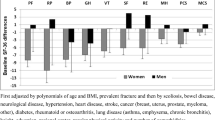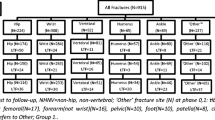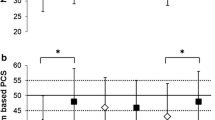Abstract
Objective: To estimate the impact of osteoporosis fractures on health-related quality of life (HRQOL) in postmenopausal women. Methods: To compare the impact on HRQOL of different osteoporotic fractures, 600 consecutive women 55–75 years old with a new fracture (inclusion fracture) were invited by mail. After exclusions by preset criteria (high-energy fractures, ongoing osteoporosis treatment, or unwillingness to participate), 303 women were included, 171 (56%) of whom had a forearm, 37 (12%) proximal humerus, 40 (13%) hip, and 55 (18%) vertebral fracture, respectively, and all were investigated and treated according to the current local consensus program for osteoporosis. In addition, HRQOL was evaluated by the SF-36 questionnaire and compared with local, age-matched reference material. Examinations were performed 82 days (median) after the fracture and 2 years later. Results: HRQOL was significantly reduced at baseline regarding all SF-36 domains after vertebral fractures and most after hip fractures, but only regarding some domains after forearm and humerus fracture. After 2 years, improvements had occurred after all types of fractures, and after forearm or humerus fracture, HRQOL was completely normalized in all domains. However, 2 years after hip fracture, HRQOL was still below normal regarding physical function, role-physical and social function, while after vertebral fracture, scores were still significantly lower for all domains, physical as well as mental. Patients with one or more previous fractures before the inclusion fracture had lower HRQOL at baseline and after 2 years, compared with those with no previous fracture. Patients with osteoporosis (T-score <−2.5 in hip or spine) had lower HRQOL than those with normal BMD. Conclusion: Vertebral and hip fractures have a considerably greater and more prolonged impact on HRQOL than forearm and humerus fractures. The number of fractures was inversely correlated to HRQOL. These differences should be taken into account when making priorities in health care programs.
Similar content being viewed by others
References
Adachi JD, Ioannidis G, Berger C, Joseph L, Papaioannou A, Pickard L et al (2001) The influence of osteoporotic fractures on health-related quality of life in community-dwelling men and women across Canada. Osteoporos Int 12:903–908
Adachi JD, Ioannidis G, Olszynski WP, Brown JP, Hanley DA, Sebaldt RJ et al (2002) The impact of incident vertebral and non-vertebral fractures on health related quality of life in postmenopausal women. BMC Musculoskelet Disord 3:11–17
Begerow B, Pfeifer M, Pospeschill M, Scholz M, Schlotthauer T, Lazarescu A et al (1999) Time since vertebral fracture: an important variable concerning quality of life in patients with postmenopausal osteoporosis. Osteoporos Int 10:26–33
Dolan P, Torgerson D, Kumar Kakarlapudi T (1999) Health-related quality of life of Colles’ fracture patients. Osteoporos Int 9:196–199
Fink HA, Ensrud KE, Nelson DB, Kerani RP, Schreiner PJ, Zhao Y et al (2003) Disability after clinical fracture in postmenopausal women with low bone density: the fracture intervention trial (FIT). Osteoporos Int 14:69–76
Hall SE, Criddle RA, Comito TL, Prince RL (1999) A case-control study of quality of life and functional impairment in women with long-standing vertebral osteoporotic fracture. Osteoporos Int 9:508–515
Lips P, Cooper C, Agnusdei D, Caulin F, Egger P, Johnell O et al (1999) Quality of life in patients with vertebral fractures: validation of the Quality of Life questionnaire of the European Foundation for Osteoporosis (QUALEFFO). Osteoporos Int 10:150–160
Oleksik A, Lips P, Dawson A, Minshall ME; Shen W, Cooper C et al (2000) Health-related quality of life in postmenopausal women with low BMD with or without prevalent vertebral fractures. J Bone Miner Res 15:1384–1392
Randell AG, Nguyen TV, Bhalerao N, Silverman SL, Sambrook PN, Eisman JA (2000) Deterioration in quality of life following hip fracture: a prospective study. Osteoporos Int 11:460–466
Silverman SL, Minshall ME, Shen W, Harper KD, Xie S (2001) The relationship of health-related quality of life to prevalent and incident vertebral fractures in postmenopausal women with osteoporosis. Arthritis Rheum 44:2611–2619
Tosteson ANA, Gabriel SE, Grove MR, Moncur MM, Kneeland TS, Melton LJ (2001) Impact of hip and vertebral fractures on quality-adjusted life years. Osteoporos Int 12:1042–1049
Kaukonen JP, Karjaharju EO, Porras M, Luthje P, Jakobsson A (1988) Functional recovery after fractures of the distal forearm: analysis of radiographic and other factors affecting the outcome. Ann Chir Gynaecol 77:27–31
Tidermark J, Zethraeus N, Svensson O, Tornqvist H, Ponzer S (2002) Femoral neck fractures in the elderly: functional outcome and quality of life according to EuroQoL. Qual Life Res 11:473–481
Ware JE, Sherbourne CD (1992) The MOS 36-Item Short-Form Health Survey (SF-36), Ι: conceptual framework and item selection. Med Care 30:473–481
Medical Products Agency (1997) Recommendations to treatment of osteoporosis (in Swedish). Medical Products Agency, Läkemedelsverket pp 7–30
Sullivan M, Karlsson J, Ware JE (1994) SF-36 Hälsoenkät Svensk manual och tolkningsguide (Swedish manual and interpretation guide). Gothenburg University Hospital, Gothenburg
Eriksson E, Nordlund A (2002) Health and health related quality of life as measured by the EQ-5D and the SF-36 in South East Sweden: result from two population surveys. Report 1 (In Swedish). Faculty of Health Science, University of Linköping, Sweden
Sullivan M, Karlsson J, Ware JE (1995) The Swedish SF-36 Health Survey, I: evaluation of data quality, scaling assumptions, reliability and construct validity across general populations in Sweden. Soc Sci Med 41:1349–1358
Persson LO, Karlsson J, Bengtsson C, Steen B, Sullivan M (1998) The Swedish SF-36 Health Survey, II: evaluation of clinical validity—results from population studies of elderly and women in Gothenburg. J Clin Epidemiol 51:1095–1103
Sullivan M, Karlsson J (1998) The Swedish SF-36 Health Survey, III: evaluation of criterion-based validity—results from normative population. J Clin Epidemiol 51:1105–1113
SPSS (1999) SPSS 10.0 version. SPSS, Chicago
Kanis JA and the WHO Study Group (1994) Assessment of fracture risk and its application to screening for postmenopausal osteoporosis: synopsis of the WHO report. Osteoporos Int 4:368–381
Johnell O, Kanis J, deLaet C, Jönsson B, Zethraeus N, Oden A (2002) Sequential changes in quality of life after osteoporotic fractures. Paper presented to IOF World Congress on Osteoporosis. Osteoporos Int 13[Suppl 1]S1–S160 (P222SA)
Gluck O, Maricic M (2002) Raloxifene: recent information on skeletal and non-skeletal effects. Curr Opin Rheumatol 14:429–432
Tostesson AN, Gabriel SE, Kneeland TS, Moncur MM, Manganniello PD, Schiff I et al (2000) Has the impact of hormone replacement therapy on health-related quality of life been undervalued? J Womens Health Gend Based Med 9:119–130
Hays J and the Women’s Health Initiative Investigators (2003) Effects of estrogen plus progestin on health-related quality of life. N Engl J Med 348:1839–1854
Acknowledgements
We thank Marit Andersson, Bibbi Gurung, and Helene Hall, Linköping University Hospital, for all help in the administration, mineral density measurements, and care of patients in the study. This study was supported by grants from the County Council of Östergötland, Sweden.
Author information
Authors and Affiliations
Corresponding author
Rights and permissions
About this article
Cite this article
Hallberg, I., Rosenqvist, A.M., Kartous, L. et al. Health-related quality of life after osteoporotic fractures. Osteoporos Int 15, 834–841 (2004). https://doi.org/10.1007/s00198-004-1622-5
Received:
Accepted:
Published:
Issue Date:
DOI: https://doi.org/10.1007/s00198-004-1622-5




